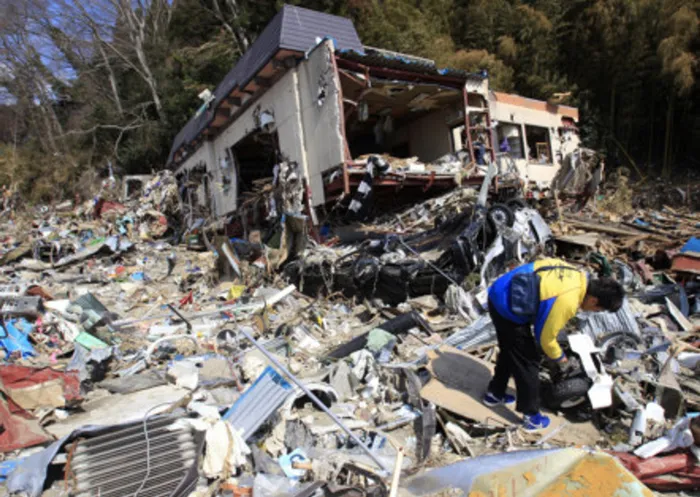Air, sea operation to recover bodies

Yashhar Suzuki, 36, search his friends belongings in the debris at the March 11 earthquake and tsunami-destroyed town of Rikuzentakata, Iwate Prefecture, northern Japan. Yashhar Suzuki, 36, search his friends belongings in the debris at the March 11 earthquake and tsunami-destroyed town of Rikuzentakata, Iwate Prefecture, northern Japan.
Thousands of Japanese and US troops launched an intensive air and sea operation on Friday to recover bodies still left from the huge earthquake and tsunami three weeks ago.
The grim search came as the government revealed radiation from a nuclear power plant crippled by the twin disaster had been found in groundwater, with contamination already reported in the air, ocean and food.
Japan is still struggling to cope with its worst post-war crisis three weeks after the seafloor quake struck on March 11, leaving about 28 000 people dead or missing.
In the search for bodies, Japanese and US armed forces deployed 120 aircraft and 65 ships for a three-day operation along the northeast coast, where houses, ships, cars and trains still lay scattered across the muddy wastelands.
Prime Minister Naoto Kan was to address the nation and then on Saturday fly to the devastated port of Rikuzentakata, and “J-village”, the base for hundreds of emergency crew who have battled at great risk to prevent a nuclear meltdown at the crippled Fukushima power plant.
Kan, who had donned emergency worker uniform since the disaster, switched to business attire Friday, showing that he now was looking to “the next stage” of restoration, government spokesman Yukio Edano said.
At the Fukushima plant, which has been leaking radiation, workers readied to spray resin on the rubble of blast-hit reactor buildings as part of their tense stop-and-go effort aimed at shutting the plant down.
The environmental impact was worsening, with high levels of iodine-131 found in groundwater 15 metres below the plant's reactor number one, and at more than 4 000 times the maximum safe level nearby in the Pacific Ocean.
Vegetable, dairy and other food shipments from four prefectures in the area have been stopped because of radiation, which the health ministry said has now also been found in beef from 70 kilometres away.
The government has issued assurances that no water or food contamination had yet reached levels that would have an immediate impact on public health.
Japan's nuclear safety agency said Tokyo Electric Power Co (TEPCO), the much-criticised operator of the Fukushima nuclear plant, had for a time not had enough radiation meters for workers battling to stabilise the facility.
The agency had admonished TEPCO, instructing it “to do the utmost to manage workers' exposure levels,” and by Friday it had sourced enough meters for its emergency crew, said agency spokesman Hidehiko Nishiyama.
TEPCO, one of the world's largest utilities, could face huge costs and compensation claims, but it may end up receiving taxpayer money because of the need to maintain a stable power supply, local media said.
“It's not an option we've ruled out so far,” Yukio Edano told a regular press briefing, responding to media reports stating that a fund injection was under consideration.
Japan has resisted a nudge from the UN nuclear watchdog this week to widen the 20-kilometre evacuation zone around the nuclear plant and clear people out of the village of Iitate, 40 kilometres northwest of the facility.
Of the village's 6 000 residents, 3 800 were still there Thursday, said local official Takashi Kobayashi by telephone.
“We are aware that a high level of radiation has been detected. But residents feel it's best to stay home... They need to take care of their cattle and other livestock,” he said.
Up to 1 000 bodies were still lying amid the tsunami's muddy debris on the coastline within the 20-kilometre exclusion zone, out of reach of rescue workers who cannot enter because of the high radiation, Kyodo News reported.
The bodies had been “exposed to high levels of radiation after death”, one official was quoted as saying, and there was concern that they were now too contaminated to be safely recovered, or even to be cremated.
In Tokyo, meanwhile, cherry trees started to blossom, usually a treasured spring event that symbolises the fragility of life, but any celebrations in the capital promised to be muted this weekend.
Tokyo's Ueno park, which usually attracts some of the largest crowds to revel below the “sakura” trees' pink canopy, has cancelled the parties for the first time since World War II, organiser Masahiro Kayano told AFP. - Sapa-AFP
